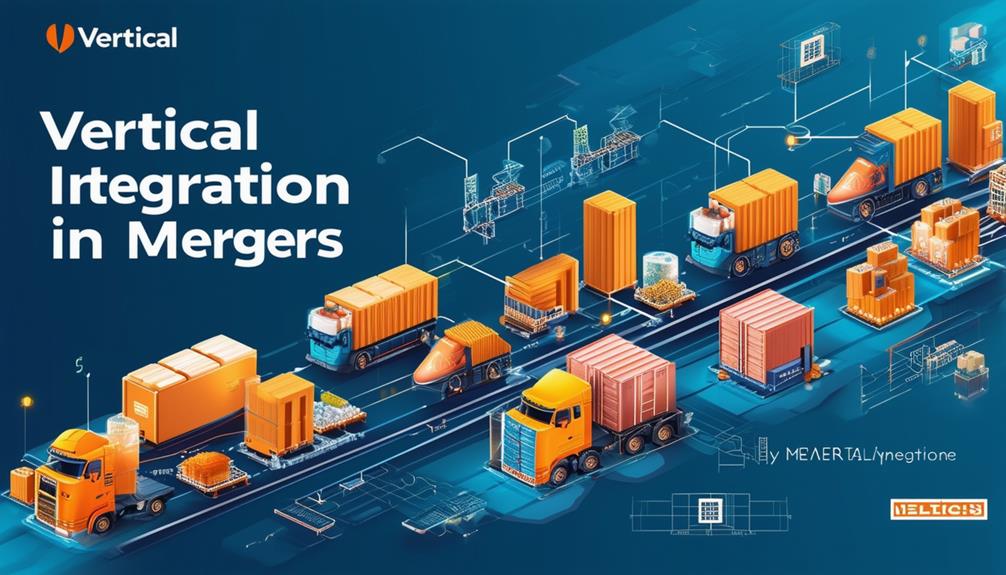The Role of Vertical Integration in Mergers

Vertical integration plays a crucial role in mergers by enabling companies to have better control over their supply chain, enhance operational efficiency, and secure a competitive edge. When firms merge along the supply chain, they can improve production processes, optimize resource utilization, and achieve cost savings. This integration not only streamlines operations and boosts productivity but also ensures high-quality standards, which in turn enhances their market positioning and cost management strategies.
Furthermore, vertical integration creates opportunities for strategic partnerships, fosters technological advancements, and encourages sustainable practices that are essential for long-term success in the business landscape. By delving into the intricacies of vertical integration, companies can unlock a plethora of benefits that significantly influence the outcomes of mergers and acquisitions.
Key Takeaways
Vertical mergers help companies control their entire supply chain, leading to cost efficiencies and higher production quality. This integration enhances market competitiveness by creating operational synergy and optimizing resources. It also reduces costs, streamlines operations, and boosts overall productivity.
Through vertical mergers, companies can strategically price their products, control distribution channels, and establish dominance in the market. This not only provides valuable lessons for optimizing operations and enhancing competitiveness but also helps in creating barriers to entry for potential competitors.
In summary, vertical mergers play a crucial role in improving a company's overall performance, market position, and long-term sustainability. By integrating various aspects of the business vertically, companies can achieve a more efficient and effective operation that sets them apart in the competitive landscape.
Definition of Vertical Integration
Vertical integration in mergers combines different companies in various supply chain functions to gain more control over production and lower costs. This strategic approach involves acquiring or establishing suppliers, manufacturers, distributors, or retail locations to create a smooth flow within the supply chain. By integrating both backward and forward aspects, companies can improve their efficiency and achieve significant cost savings.
In a merger situation, vertical integration is crucial for aligning different stages of the production process under one umbrella, enabling better coordination and synergy between functions. This comprehensive control optimizes operations and reduces expenses linked to third-party involvement.
Through vertical integration in mergers, companies can refine their production processes, closely monitor quality standards, and quickly adapt to market demands. This integration empowers businesses to navigate the complexities of the supply chain with precision and agility, fostering innovation and competitiveness in the marketplace.
Importance of Supply Chain Control
Vertical integration is a key factor in mergers as it allows companies to have control over different parts of the supply chain, like supply chain efficiency, cost-cutting strategies, and quality assurance. When businesses integrate vertically, they can streamline operations, improve coordination, achieve cost savings, and boost overall productivity.
This control over the supply chain empowers companies to effectively manage quality, pricing, and delivery schedules, reducing reliance on external suppliers and gaining a competitive advantage in the market.
Supply Chain Efficiency
Vertical integration in mergers offers a strategic advantage by tightly controlling the sourcing of raw materials, production stages, and final product distribution. This integration allows companies to align their production processes with market demands, reduce lead times, and optimize resource utilization within the supply chain. As a result, operational agility is improved, costs are reduced, and overall supply chain performance is enhanced. Quality control is also strengthened, ensuring that products consistently meet the desired standards at every stage of production.
The benefits of supply chain efficiency in vertical mergers are numerous. Operational agility is enhanced, allowing companies to respond quickly to market changes and customer demands. Cost reduction is achieved by streamlining processes and minimizing waste. Quality control ensures that high standards are maintained throughout the production cycle. Improved coordination fosters collaboration and efficiency across different production stages. Ultimately, companies gain a competitive edge by optimizing their supply chain performance through vertical integration in mergers.
Cost Reduction Strategies
Implementing cost reduction strategies relies on tightly controlling the supply chain to eliminate inefficiencies and optimize production processes. Vertical mergers play a crucial role in achieving these objectives by integrating different stages of the supply chain under one company. This integration helps in streamlining operations and taking advantage of economies of scale. Companies that pursue vertical mergers can manage costs effectively by overseeing production, distribution, and sales processes.
Vertical mergers allow companies to have better control over their supply chain, leading to significant cost savings and operational efficiencies. By consolidating different aspects of the business, companies can reduce duplication of efforts and streamline communication between various departments. This level of integration enables companies to make strategic decisions that drive down costs and improve overall performance.
Historically, companies like Disney's acquisition of Pixar and Marvel Entertainment showcase the benefits of vertical mergers in reducing costs and enhancing competitiveness. These mergers enabled Disney to expand its content offerings and distribution channels while cutting down on production and marketing expenses. The success of these mergers highlights the strategic advantage of vertical integration in achieving cost efficiencies and driving growth in competitive markets.
Quality Assurance Measures
Quality assurance measures in a vertically merged supply chain are crucial for ensuring consistent product quality and upholding the brand's reputation.
In a vertically merged system, companies have the advantage of overseeing the entire supply chain, enabling them to implement standardized quality checks and procedures at every production stage. This oversight allows for immediate resolution of any quality issues that may arise, thus safeguarding the brand's reputation.
With full control over the supply chain, the risk of inferior components or products entering the production process is significantly diminished. Ultimately, these quality assurance measures play a pivotal role in enhancing customer satisfaction and loyalty by ensuring the delivery of reliable products that meet or exceed expectations.
In the business world, where innovation is key, vertical mergers alongside rigorous quality control measures prove to be a winning combination for companies striving to excel in their industry and maintain a competitive edge.
Advantages of Vertical Integration

Vertical mergers improve efficiency and control in the production process, leading to cost savings and enhanced quality. By combining different production stages within a single entity, companies can streamline operations and benefit from economies of scale. This integration also ensures better quality control as companies oversee each production step directly, guaranteeing high product standards.
Moreover, vertical mergers enhance coordination along the supply chain, boosting overall efficiency. When companies merge with suppliers or distributors, they create synergies in operations, finance, and management, resulting in cost savings and improved business performance. This tighter control and coordination facilitate operational optimization, increased profitability, and competitiveness in the market. Ultimately, vertical mergers offer opportunities to enhance operational efficiency, reduce costs, and maintain quality standards throughout the supply chain.
Economies of Scale Benefits
Vertical mergers bring about substantial advantages in terms of economies of scale. This integration of operations along the supply chain enables cost savings through increased scale, leading to greater efficiency in production processes.
Cost Savings Through Scale
By consolidating different production stages under one roof, companies can achieve significant cost savings through vertical mergers. This strategic move allows firms to take advantage of economies of scale, leading to lower per-unit production costs and increased profitability. With vertical integration, companies can benefit from bulk purchasing discounts and stronger bargaining power with suppliers, optimizing their allocation of resources and streamlining operations.
Vertical mergers enable companies to spread fixed expenses across a larger output volume, resulting in substantial cost reductions. This cost-saving strategy not only allows businesses to offer competitive pricing to consumers but also ensures healthy profit margins. By embracing economies of scale through vertical integration, organizations can enhance their market position and create sustainable value for stakeholders.
Furthermore, vertical mergers foster innovation and growth opportunities by combining streamlined production stages, bulk purchasing advantages, and optimized resource allocation. This synergy empowers companies to thrive in a competitive market landscape, driving financial efficiency and strategic growth. Embracing cost savings through scale through vertical mergers is key to building a strong market presence and sustaining long-term success in the industry.
Streamlined Production Processes
Streamlining production processes through vertical integration can result in significant cost reductions and increased competitiveness for companies. By integrating different stages of the supply chain, businesses can benefit from economies of scale, leading to lower average costs per unit as production volumes increase. This coordinated approach optimizes production, minimizes waste, and ensures better quality control at every step.
Vertical integration also helps in reducing lead times and improving overall efficiency, enabling companies to bring their products to market faster. This streamlined production approach gives companies a competitive edge by allowing them to deliver goods more quickly and efficiently than their competitors. Embracing vertical integration and focusing on optimizing production processes are essential strategies for companies striving to stay ahead in today's fast-paced business environment.
In mergers and acquisitions, vertical integration plays a crucial role in enhancing operational efficiency and driving innovation. Companies that successfully integrate vertically can unlock new opportunities for growth and expansion. By aligning their supply chain and production processes, businesses can better control costs, improve product quality, and respond more effectively to market demands. This strategic approach not only boosts competitiveness but also fosters a culture of continuous improvement and adaptation in a rapidly changing business landscape.
Competitive Pricing Strategies
Vertical mergers involve the consolidation of companies operating at different stages of the supply chain. By merging with or acquiring businesses that are either suppliers or customers, companies can streamline operations and potentially achieve cost efficiencies that can be passed on to consumers through competitive pricing strategies.
One key benefit of vertical mergers is the potential for cost advantages. By integrating different stages of production, companies can eliminate markups and inefficiencies that often exist when dealing with external suppliers. This can result in lower production costs and, ultimately, more competitive pricing in the market.
Efficient operations are another advantage of vertical mergers. When companies merge with businesses along the supply chain, they can align production processes and reduce redundancies. This streamlining of operations can lead to increased efficiency, which is essential for maintaining competitiveness through attractive pricing strategies.
Moreover, companies engaging in vertical mergers can leverage their newfound cost advantages to offer better prices than competitors who rely solely on external suppliers. By controlling more aspects of the supply chain, these companies have more flexibility in setting prices and can potentially attract more customers with their competitive pricing strategies.
Enhancing Operational Efficiency

In mergers, integrating operations vertically is key to boosting operational efficiency. By merging with entities at different production levels, companies can streamline processes, cut costs, and enhance control over the production chain. This leads to increased productivity and better resource management, ultimately improving overall performance.
Vertical integration not only streamlines operations but also fosters better resource allocation and decision-making. It helps in eliminating bottlenecks, improving the flow of goods and services, and enhancing coordination within the supply chain. This strategic approach provides a comprehensive view of the business, enabling companies to innovate, increase efficiency, and maintain competitiveness in a fast-paced market environment.
Regulatory Challenges in Vertical Mergers
Vertical mergers face regulatory challenges due to concerns about diminished market competition and potential violations of antitrust laws. Regulators closely examine these mergers to assess their impact on market dynamics and ensure fair competition.
Issues such as impeding competitors and controlling the supply chain can prompt regulatory action to preserve market fairness.
Regulatory Hurdles in Vertical Mergers
Vertical mergers face significant challenges when it comes to regulatory approval. These challenges revolve around market competition, antitrust concerns, and the consolidation of control over the entire supply chain. These factors can greatly influence the outcome and approval process of vertical mergers.
Regulatory bodies carefully evaluate how a vertical merger might impact market competition. If there's a potential decrease in competition as a result of the merger, regulators are likely to intervene to ensure a level playing field for all market participants.
Antitrust violations are a common concern in vertical mergers. The fear is that the merged entity could become a dominant player in the market, potentially leading to unfair practices that harm competition and consumers. It's essential for companies engaging in vertical mergers to address these antitrust concerns proactively.
Regulators also pay close attention to how much control the merged entity would have over the entire supply chain. By controlling multiple stages of production and distribution, the merged entity could limit choices for consumers and potentially stifle innovation in the market.
Successfully navigating these regulatory hurdles requires a deep understanding of market dynamics and a strategic approach to address concerns related to competition, antitrust, and supply chain control. Companies involved in vertical mergers must be prepared to engage with regulators, provide necessary information, and propose solutions that mitigate any potential negative impacts on competition and consumers.
Compliance Issues in Integration
Navigating the complex regulatory landscape surrounding vertical integration can be a real challenge for companies going through mergers. Issues like anti-competitive behavior and concerns about dominating the market are top of mind when it comes to vertical mergers. Compliance problems may arise if the integration leads to unfair control of the market or the exclusion of competitors. It's crucial for companies to handle these regulatory hurdles properly to ensure they're following the rules. Entities like the FTC and DOJ keep a close eye on these mergers to make sure competition stays fair and to prevent any monopolistic behaviors.
Companies that are involved in vertical mergers need to be on their toes to deal with these complexities and stay compliant with regulations. The scrutiny from regulatory bodies is there to make sure the market stays competitive and that everyone has a fair chance to succeed. By tackling compliance issues head-on and being transparent about their actions, companies can show that they're committed to doing business the right way. It's important for companies to be aware of how the regulatory landscape is changing and be ready to adapt to the challenges that come with vertical integration in mergers.
Strategic Analysis for Integration Success

When diving into the evaluation of the value chain, it's crucial to identify where vertical mergers can bolster our competitive edge. By pinpointing these opportunities, we set the stage for long-term success in the market.
In the realm of mergers and acquisitions, achieving cost savings is a top priority. By focusing on specific areas within the value chain, we can streamline operations, cut down on expenses, and ultimately increase our profitability.
Operational efficiencies are key to the success of any integration. Understanding how merging vertically can optimize processes and workflows is essential for maximizing productivity and overall performance.
In the world of mergers, vertical integration plays a significant role in reshaping industries and driving growth. Companies that strategically analyze and leverage vertical mergers stand to gain a competitive advantage, achieve cost savings, and enhance operational efficiencies. It's a dynamic landscape where innovation and strategic vision converge to create lasting value for stakeholders.
Financial Implications of Vertical Mergers
Vertical mergers have a significant impact on the financial health of the companies involved. These mergers allow firms to achieve cost synergies, explore new revenue streams, and diversify their risk exposure. The financial benefits of vertical mergers can result in increased profitability, better cash flow management, and more strategic capital allocation.
Cost synergies analysis is a key aspect of vertical merggers, as it enables companies to streamline their operations and reduce expenses. By combining complementary resources and capabilities, firms can lower production costs and improve overall efficiency. This can lead to higher profit margins and improved financial performance.
Additionally, vertical mergers provide companies with access to new revenue growth opportunities. By integrating different stages of the supply chain or distribution network, firms can capture a larger share of the market and increase their sales. This can result in enhanced top-line growth and improved market competitiveness.
Furthermore, vertical mergers allow companies to implement risk diversification strategies. By expanding their business reach across multiple segments of the industry, firms can reduce their exposure to individual market fluctuations or disruptions. This can help safeguard against unforeseen events and provide more stability to the company's financial position.
Cost Synergies Analysis
When we look at vertical mergers from a financial perspective, our main focus is on analyzing the potential cost synergies that can arise from combining operations to achieve economies of scale and cost efficiencies. In this analysis, we consider various aspects such as:
- Reductions in Operating Expenses: We look for opportunities where streamlining operations after the merger can lead to reduced costs.
- Overhead Costs Optimization: We explore ways to eliminate duplication and cut unnecessary overhead expenses through integration.
- Utilizing Financial Modeling: This is crucial for quantifying the expected cost savings and synergies, which helps in evaluating the financial feasibility and benefits of vertical integration.
Vertical mergers can create significant cost synergies by optimizing operations, reducing redundancies, and improving overall efficiency. By carefully assessing these factors, companies can enhance their competitive position and drive greater value from the merger.
Revenue Growth Potential
Exploring the revenue growth potential in vertical mergers uncovers opportunities to maximize value by gaining control over the entire supply chain and improving operational efficiencies. Vertical integration enables companies to align different production stages, leading to increased value capture and revenue generation through more streamlined processes. By consolidating operations, companies can achieve cost savings, ensure quality control, and leverage synergies throughout the supply chain. The enhanced revenue potential from vertical mergers is driven by economies of scale, efficient operations, and broader market penetration.
Furthermore, vertical integration opens up new revenue streams, creates cross-selling opportunities, and strengthens competitive positioning in the market. Embracing vertical mergers not only boosts revenue growth but also fortifies the overall business model, setting the stage for sustained success and innovation. As companies harness the advantages of vertical integration, they position themselves for long-term growth and profitability in a fiercely competitive business environment.
Risk Diversification Strategies
Vertical mergers involve strategically spreading financial risks across different stages of the supply chain to enhance stability and resilience in volatile markets. This strategic approach allows companies to optimize resources, enhance competitiveness, and mitigate financial uncertainties associated with external factors. By diversifying risks through vertical integration, companies can achieve more stable financial performance and greater resilience in dynamic market conditions.
Integrating vertically helps companies reduce exposure to market fluctuations and disruptions in specific segments, leading to enhanced stability. This can be crucial for maintaining a strong position in the market and adapting to changing economic conditions. Additionally, vertical mergers empower companies to control costs effectively by streamlining operations across different stages of the supply chain, ultimately improving cost management and operational efficiency.
The diversified operations resulting from vertical integration contribute to the overall financial health and sustainability of companies in the long term. This can lead to improved performance, growth opportunities, and a competitive edge in the industry. By strategically diversifying risks through vertical mergers, companies can navigate uncertainties, seize opportunities, and establish a solid foundation for sustained growth and success in the ever-evolving business landscape.
Vertical Merger Case Studies

Vertical merger case studies offer valuable insights into the strategic decisions and outcomes of companies that unite content creation with distribution channels. One notable example is the merger between Time Warner Inc. and Turner Corporation in 1996, which aimed to capitalize on synergies and boost operational efficiency. This strategic move was a precursor to a more recent significant vertical merger in the media industry – AT&T's acquisition of Time Warner for $85.4 billion in 2018.
The AT&T-Time Warner merger, despite facing regulatory scrutiny, was driven by the ambition to compete with tech giants and establish a media powerhouse with assets spanning TV, film, and telecommunications. This merger exemplifies how vertical integrations, like AT&T-Time Warner, can reshape industries by intertwining content creation and distribution capabilities. Companies can draw valuable lessons from these real-world examples to navigate similar strategic moves in the dynamic business landscape.
Analyzing these case studies sheds light on the successes and challenges encountered by industry leaders in executing vertical mergers. By understanding the strategies and outcomes of these mergers, companies can gain insights into how to leverage synergies and enhance their competitive positions in the market. The evolving landscape of mergers and acquisitions underscores the importance of strategic decision-making and effective integration of content creation and distribution channels for sustainable growth and success.
Impact on Industry Dynamics
Vertical integration in mergers plays a crucial role in shaping industry dynamics by impacting market power and supply chain relationships. When companies merge vertically, they gain the ability to control pricing strategies and distribution channels, giving them a significant advantage in the market. This increased market power allows them to influence competition and potentially limit the entry of new players into the industry.
By consolidating different stages of the supply chain, firms engaging in vertical integration can create barriers to entry for potential competitors. This control over essential parts of the supply chain makes it challenging for new entrants to establish themselves and compete effectively. This, in turn, reinforces the position of the integrated companies within the industry and solidifies their competitive edge.
Furthermore, vertical integration in mergers can result in cost savings and operational efficiencies for the companies involved. By streamlining operations and reducing costs through integration, firms can improve their overall performance and profitability. This strategic approach to mergers and acquisitions not only impacts individual companies but also influences the competitive landscape of the industry as a whole.
Competitive Edge Through Integration

By pursuing vertical mergers, we aim to strengthen our market position by integrating different stages of the production process. This strategic approach allows us to enhance our control over suppliers, manufacturers, and distributors, leading to streamlined operations and cost efficiencies. Through these mergers, we can create a significant competitive advantage in the market.
Vertical mergers help us establish barriers to entry for competitors, solidifying our market position and increasing our competitiveness. By integrating various elements of the supply chain, we not only enhance operational efficiency but also improve our ability to deliver top-notch products and services to customers. This proactive strategy distinguishes us from competitors and positions us as pioneers in innovation and operational excellence in the industry.
Lessons From Successful Vertical Mergers
Drawing insights from successful vertical mergers, companies have uncovered valuable lessons in optimizing operations and harnessing synergies across various supply chain functions. These mergers have provided key learnings that have paved the way for improved management efficiencies and enhanced integration strategies.
One crucial lesson is the importance of identifying synergies between the merging entities, particularly in operational processes and supply chain dynamics. By recognizing these synergies, companies can better align their strategies and enhance overall performance.
Streamlining operations has emerged as a critical aspect in successful vertical mergers, highlighting the need to eliminate redundancies and enhance workflow efficiency. This streamlined approach not only improves productivity but also fosters a more agile and responsive supply chain.
Furthermore, the significance of well-planned integration strategies can't be overstated. Companies have realized that a carefully crafted integration plan is essential for ensuring a seamless transition post-merger, leading to a harmonized and efficient supply chain ecosystem.
Future Trends in Vertical Integration

Vertical mergers are becoming increasingly popular as companies seek to enhance supply chain control and improve cost efficiencies. The future of vertical integration is moving towards more strategic partnerships and collaborations. By forming alliances with other industry players, companies can streamline operations and optimize processes within their supply chains. Automation and technological advancements will play a key role in driving these integration efforts forward. Implementing cutting-edge technologies like AI and IoT can revolutionize production processes and inventory management, leading to increased efficiency and reduced costs.
Environmental sustainability is also becoming a crucial aspect of vertical integration strategies. Companies are expected to prioritize ethical sourcing practices and eco-friendly initiatives to meet consumer demands for sustainable products. As industries continue to evolve, integrating sustainability practices will be essential for long-term success.
Exploring emerging markets presents new opportunities for companies to implement vertical integration strategies. By expanding into these markets, organizations can leverage their integrated supply chains to gain a competitive edge and drive growth. Embracing these future trends will be crucial for companies looking to thrive in a constantly changing business environment.
Conclusion and Key Considerations
As we wrap up our discussion on vertical integration in mergers, it's crucial to explore the key factors that can influence the success of these strategic decisions. When looking at the implications of vertical integration, important factors to consider include:
- Cost Efficiency: Vertical mergers can lead to significant cost savings by taking advantage of economies of scale and improving operational efficiencies.
- Streamlined Supply Chain: Owning multiple stages of the production process allows companies to optimize their supply chain operations, reducing bottlenecks and enhancing overall efficiency.
- Enhanced Market Control for Competitive Edge: Vertical integration empowers companies to have greater control over their market presence, enabling them to adapt more quickly to changing market conditions and gain a competitive advantage.
Frequently Asked Questions
What Is Vertical Integration in Mergers and Acquisitions?
Vertical mergers in the realm of business involve combining companies that operate at different stages of the production process. This strategic move aims to streamline operations, cut costs, and strengthen market position. By linking our supply chain, overseeing production processes, and integrating strategically, we can enhance control over our operations and pave the way for business growth.
Vertical mergers can lead to increased efficiency and improved coordination between different parts of the business. This integration allows for better communication and collaboration, ultimately boosting productivity and effectiveness. Moreover, by consolidating our resources and expertise, we can gain a competitive edge in the market and expand our reach to a wider audience.
In the world of mergers and acquisitions, vertical integration stands out as a powerful tool for companies looking to optimize their operations and achieve market dominance. By aligning our business strategies and combining forces with complementary entities, we can unlock new opportunities for growth and success. Embracing vertical mergers can propel us towards a more efficient, cost-effective, and influential position in the industry.
What Is the Purpose of a Vertical Merger?
When we merge different stages of the supply chain, we do it to improve efficiency. The goals of a vertical merger include achieving cost savings, increasing market power, and enhancing control efficiencies. By combining different parts of the supply chain, we aim to gain a competitive advantage, improve product quality, and reduce risks. Our focus is on finding synergies between the merged entities and ensuring smooth integration.
Vertical mergers are strategic decisions that can lead to significant benefits for companies involved. They can help streamline operations, reduce costs, and create a more integrated and coordinated business structure. By bringing together complementary resources and capabilities, companies can strengthen their market position and adapt more effectively to changes in the business environment.
What Is the Role of Vertical Integration?
Vertical mergers help companies streamline operations, cut costs, and strengthen their market position. By merging with companies that operate at different stages of the supply chain, firms can improve efficiency and gain a competitive edge. This strategy allows businesses to have more control over their suppliers, reduce risks, and spur innovation in product development. Ultimately, vertical mergers can lead to market dominance and increased profitability.
What Is the Main Purpose of Vertical Acquisitions?
Our primary goal with vertical mergers is to streamline our supply chain, boosting our competitive advantage. By combining different aspects of our operations, we can realize cost efficiencies, strengthen our market position, and enhance overall operational effectiveness. This strategic approach not only drives innovation but also sets the stage for sustained success in the marketplace.
Conclusion
In mergers, vertical integration serves as the essential link that connects different stages of production, ensuring a smooth flow of resources and activities. This strategic alignment functions like a well-coordinated orchestra, allowing companies to expand efficiently, streamline operations, and outperform their rivals. Embracing vertical integration in mergers remains a crucial element for success in the ever-changing business landscape, driving firms towards increased growth and profitability.
Vertical mergers bring together entities operating at different levels of the supply chain, fostering synergies and enhancing overall performance. By integrating production, distribution, and other key functions, companies can gain more control over their operations and minimize dependencies on external partners. This integrated approach not only improves operational efficiency but also enables firms to adapt quickly to market changes and seize new opportunities.
The concept of vertical integration has a long history of success in various industries, from technology to retail. Companies like Apple and Amazon have leveraged vertical mergers to strengthen their competitive position and create value for their stakeholders. By combining complementary capabilities and resources, these firms have been able to deliver innovative products and services, setting themselves apart in crowded markets.
Overall, vertical integration in mergers offers a strategic advantage that propels companies towards sustainable growth and profitability. By aligning different parts of the supply chain under one roof, firms can enhance their operational effectiveness, drive innovation, and stay ahead of the competition. As businesses continue to evolve, the role of vertical mergers as a catalyst for success is likely to remain prominent, shaping the future of industries and driving economic progress.





